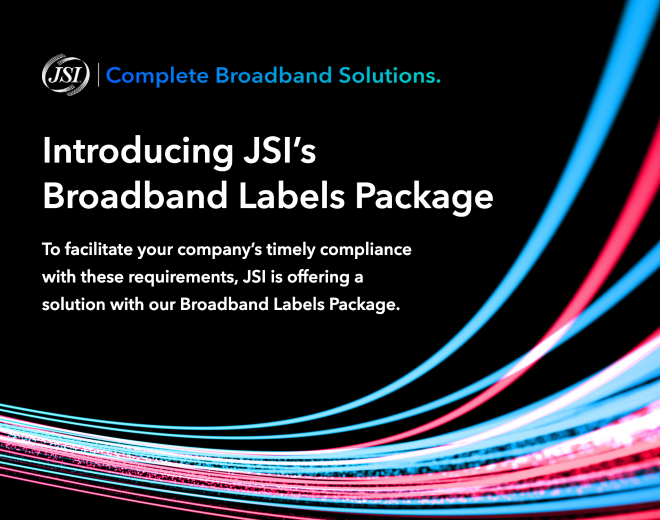Broadband Labels FAQ LP
Broadband Labels FAQ
To help providers understand the FCC’s broadband labeling compliance obligations, JSI has prepared the following FAQ.
Broadband
Labels
FAQ
The FCC does not specify a testing location. However, JSI recommends testing to a Speedtest server on the Service Provider’s Internal Network. Ideally, the server meets these criteria:
- Publicly available Ookla Speedtest server
- High performance and connected at 10 Gbps or better
- Connected to the Service Provider’s core without any bottlenecks, such as a firewall
Because the labeling requirements are focused on the speeds service provider’s deliver to customers, JSI recommends testing from broadband access equipment that provides service to subscribers. Testing should be done in a way that mimics subscriber experience so that the results are replicable by subscribers doing the same test.
CAF testing is focused on testing to FCC-designated Internet exchange points or specific carriers. The FCC does not require applying the same requirements to broadband label testing at this time. This is helpful because it allows testing to be performed under a service provider’s control without introducing uncontrollable variables.
Since testing should be performed under subscriber conditions, any issues discovered should be resolved through corrective measures until test results consistently match what is advertised on the label. This may involve troubleshooting Speedtest server performance, subscriber profiles, etc., until good results are achieved. This process aligns with the labels’ goal: to present customers with a label that represents the speed they should expect to receive.
JSI offers a full suite of compliance solutions designed to assist with establishing a testing plan and a standard form to document the tests. JSI can also assist with the engineering and deployment of a local Speedtest server if needed.
Under the FCC rules, you must have a label for each standalone residential and business broadband, standardized, mass-market service plan offering (i.e., an offering not bundled with other services such as multichannel video or voice). You do not need to make a label for bundled plans where you offer broadband Internet access service bundled with other services. You may note your bundled plans via a link in the “click here” section of the label where you describe other discounts.
Please note that enterprise service offerings or special access services are not “mass-market retail services” and are exempt from the label requirement.
- Enterprise service offerings are typically offered to larger organizations and government customers through customized or individually negotiated terms of their service contracts. The provider or the reseller is not providing a standardized, mass-market service.
- Special access is the non-switched transport of voice and data over a dedicated line between two or more designated points.
Regarding ACP, providers must indicate whether they participate in the ACP and include a link to information about the ACP on their broadband label. For the E-Rate and RHC Program, participants must provide a broadband label along with any competitive bids submitted during the competitive bidding process.
Providers must display “typical upload and download speeds and typical latency” on the labels.
Concerning alternate sales channels, if you can ensure the customer has access to an Internet connection at home, through their mobile device, or at the retail store, you can provide your weblink or send a QR code. Providing the label over the phone is just another option. If a call center staff or sales rep decides to provide the label over the phone, they must recite the entire label for each plan to the potential customer. However, if you can’t ensure the customer has an Internet connection at home or in the retail location, you must make the label available in hard copy. Also, it is important to note that you must document each instance when you direct a customer to a label and retain the documentation for two years.
Suppose your early termination fee is prorated based on the time the customer cancels service. In that case, you may note that in the label, along with the maximum early termination fee, and include a link to more details about your early termination policies.
The FCC does not address any concerns with litigation in the form of class action lawsuits if the labels are inaccurate in the order. However, the FCC will use its existing transparency enforcement procedures, forfeiture authority, and other remedies to deter noncompliance and to hold providers that do not comply with the label requirements accountable.
The FCC also notes that requiring providers to archive all labels they display will allow the FCC to obtain labels and investigate the accuracy of the labels faster and more efficiently.*
Additionally, labels that include the same information in a conspicuous location and are presented in the same format across providers will enable customers to hold those providers accountable by making inquiries and filing complaints should the services they receive or the prices they pay not match what providers display in the labels. The FCC intends to process and serve informal consumer complaints regarding broadband labels as vigorously as other informal complaints. The labels will have a link to an FCC Glossary page containing information for customers on filing complaints with the FCC.
*The Transparency Rule requires that providers’ information about their broadband service must be accurate and truthful. The FCC monitors how well providers disclose the broadband speed they give consumers and at what price. The FCC is concerned about providers who make false, misleading, or deceptive statements about their services.
You must keep documentation sufficient to support the accuracy of the labels’ content. This includes speed and latency testing results, network management practice, and the company’s privacy policy. You must archive and store all labels for at least two years once a plan is no longer available for new customers. This archive must include all labels no longer available on your website and alternative sales channels. Another critical step to evidence compliance is to develop and implement procedures for making any necessary label changes, including website updates, and train customer service representatives, sales agents, and other personnel.
In November 2022, the Federal Communications Commission (FCC) introduced new rules for broadband Internet providers, mandating the display of labels at the point of sale. These labels must disclose information about broadband prices, introductory rates, data allowances, and speeds while also including links to network management practices, privacy policies, and the Commission’s Affordable Connectivity Program.
On September 19, 2023, the Office of Management and Budget approved the information collection requirements for these rules.
The FCC has now announced compliance deadlines for these Broadband Labels:
Providers with 100,000 or fewer subscribers must comply by October 10, 2024, while all other providers must comply by April 10, 2024.
Additionally, all providers must comply with the obligation to ensure that labels are accessible in online account portals and the requirement to present the labels in a machine-readable format on the provider’s websites through a dedicated URL by October 10, 2024.














